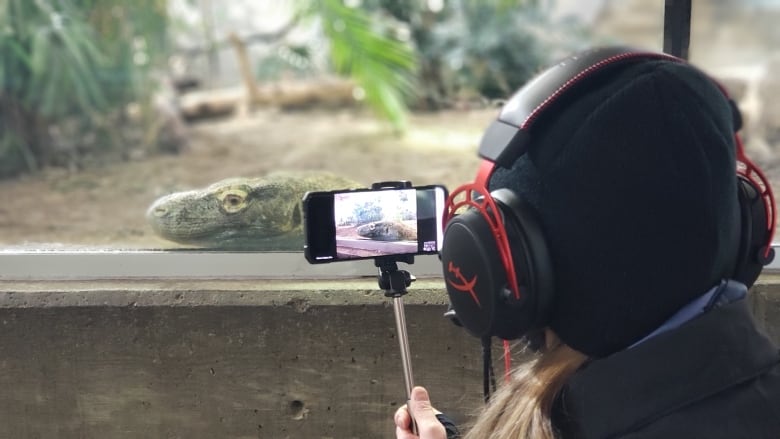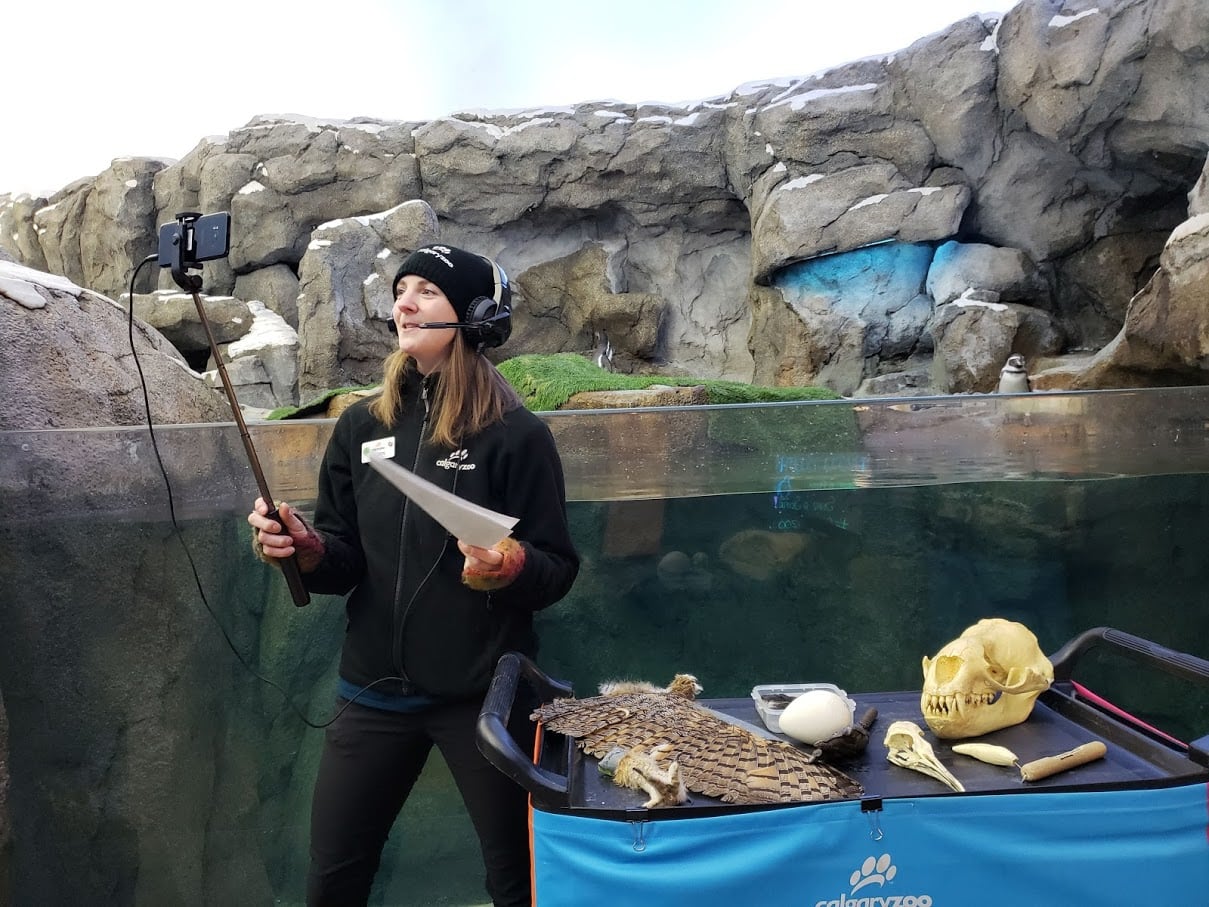How virtual field trips are bringing animals, art, music and more directly to student…
Among her childhood artistic inspirations, spoken word artist and singer I.M.F. recalls visitors at her school assemblies. Seeing performers and spoken word artists at a young age boosted her confidence to pursue that path; she’s hoping to come full circle with virtual field trip experiences she’s taken part in this month with the Art Gallery of Ontario.
“I hope there is someone out there today watching and [thinking], ‘I can do it and I’m going to start,'” the Toronto-based singer and spoken-word artist said of her Friday sessions with musical partner Raffiki.
In live-streamed sessions led by an AGO specialist, I.M.F. and Raffiki reflect on specific artworks from the gallery’s collection and then perform new creations inspired by those works. Woven through the half-hour visits, they respond to chatroom queries and feedback from students tuning in from their homes and classrooms.
“I want the kids to be inspired to take this and and start something of their own. Art is beautiful. It’s powerful. We’re able to have these important conversations using art and really shed light on Black creatives and Black artists,” I.M.F. said.

“Looking at [an artwork], having those conversations, but then introducing that auditory piece where we have the music playing — DJ Raffiki with his set, then me being able to sing and him accompanying me on the drums — it was amazing. The feedback was great.”
The coronavirus pandemic has stopped many classes from venturing out on trips and halted groups making in-school visits, but some Canadian cultural institutions are revamping their educational programming to offer virtual field trips that reach students in nearby neighbourhoods, across the country and beyond.
Access and engagement
Having the duo join AGO virtual field trip sessions to show students Black artists as part of contemporary life has been “so exciting, goosebumps-exciting,” according to Audrey Hudson, the gallery’s chief of education and programming.
When imagining how to stay connected with schools during this unprecedented time, Hudson and her team aimed to recreate the magic moments from in-person visits when students respond enthusiastically to an art educator explaining a piece of art in front of them.
She also wanted to make the digital experiences — themed, live-streamed 30-minute sessions that spotlight art from the AGO, include a wellness component and end with an art activity for students to complete — as widely available as possible.
“I wanted it to be live, so that we could nurture those conversations and listen and hear students as we would in the gallery,” Hudson said. “I really wanted to think about cultural, economic and geographic access to art. Who sees art and who doesn’t? Who has access to the arts? I wanted to bring it to mass audiences, more so than we could bring in the gallery.”
Nurturing a vibrant chatroom experience has been an important evolution that’s fostered student participation. Hudson has also been happy to discover students sharing the artwork they create following the sessions on social media.

At the Calgary Zoo, pandemic closures challenged the education team to expand on earlier digital offerings to create more robust virtual visits.
“We didn’t want to just take our in-class programs or in-person programs and put them online. We wanted to really leverage and really take advantage of what virtual can offer,” said Jen Duffy, the Calgary Zoo’s conservation education specialist.
“I, as a single human with a camera, can go places that 30 young students can’t go,” she said. Duffy has visited young chicks in the penguin habitat and gotten up close and personal with a komodo dragon for her virtual sessions. “We can sort of see [the animals]a little bit differently than we would with a big crowd.”
Connecting with students through conversations in spite of the distance was also a priority.
“In an online program, it can be pretty easy to sort of just shut off and watch. But our educators are so engaging: answering questions and asking questions and breaking that fourth wall,” Duffy said.
“We’ve had beautiful questions from students, even trying to grapple with the situation of the pandemic: asking about animal diseases or asking about how diseases are transmitted. And that’s really interesting to talk about with them.”
WATCH | Calgary Zoo specialist on the value of virtual experiences:
Conservation education specialist Jen Duffy on what the Calgary Zoo has learned in boosting its virtual experiences for students. 0:42
Working with teachers
Collaborating with educators to develop virtual programs and ensure they connect to current curriculum is also important. A teacher advisory group that works closely with the Library of Parliament in Ottawa, for instance, has been a valuable part of creating lesson plans for Parliament: The Classroom Experience — as well as for spreading the word about the new project to colleagues, said Kit Frost, the library’s chief of virtual experience.
Parliament: The Classroom Experience was crafted as a way to continue “visits” — via virtual reality — to Parliament’s iconic Centre Block during its extended closure for restorations and renovations. However, after the pandemic scuttled the project’s launch in spring 2020, the education team spent last summer and early fall retooling it into a 360-degree video experience that doesn’t require VR headsets.
“Things change so quickly in classrooms. We wanted to ensure that it would be useful to teachers and something that they could just grab and go,” said Frost.
“Teachers are very appreciative right now of any resources that would allow them to take their students on a field trip — even for 20 minutes. I think that we’ve all been challenged during the pandemic to find ways to connect, to find ways to to visit places, see things, do things we can’t do.”
WATCH | A vibrant look at Parliament’s Centre Block during its closure:
How a 360 video project is keeping the currently under-renovation Centre Block open for ‘virtual visits’ by students across Canada. 1:42
The teams behind several of these projects are already seeing success in reaching more students than ever before, in spite having just a few months of experience under their belts.
“Between October and right now, we’ve had over 70,000 users of the [Parliament: The Classroom Experience] 360-degree video and the classroom website is not that far behind,” Frost said. “We’re getting pretty good use and the visit times are pretty high.”
The AGO’s educational programming reaches about 40,000 students in a typical school year, noted Hudson. That figure has skyrocketed due to the virtual program, she said, with 42 per cent of the current “visitors” coming from outside Toronto, where the gallery is based, compared to just nine per cent before.
“Seeing that we reached over 180,000 students in 10 weeks [through virtual school trips], that for me is just absolutely phenomenal. And it speaks to the need, speaks to the desire [for] a program such as this.”
The only major impediment to participation has been time zones, said Calgary Zoo’s Duffy.
“We’ve talked to some people in Japan. We’ve talked to some folks definitely outside of Alberta: in Ontario, in B.C. We had a few folks from the [United] States,” she said. “Once we can [reopen the zoo] safely, everybody can come. But if we can reach them now without any geographic barriers, we are happy to do so.”
WATCH | Virtual content spreads VSO’s music education far beyond Vancouver:
Christin Reardon MacLellan, Vancouver Symphony Orchestra’s director of education, describes how its new virtual subscription offerings is spreading world-class music education wider than ever before. 1:53
In response to the pandemic, the Vancouver Symphony Orchestra launched a subscription-based online concert hall with a dedicated virtual education section dubbed The Music Room. “It’s kind of like Netflix for orchestra,” said Christin Reardon MacLellan, VSO director of education and community programs.
The B.C. orchestra usually sees about 50,000 young people a year, from students who travel to Vancouver’s Orpheum Theatre for concerts to those who welcome VSO musicians into their schools across the Lower Mainland.
“This year, with the total online subscriptions we have, including [those purchased by] school districts, we estimate that we’re able to reach about 200,000 people. So it’s almost quadrupled,” MacLellan said.
“We’ve always aspired to have virtual programming and a digital concert hall, but until the pandemic hit there always seemed to be so many other things to be doing.”
A silver lining of COVID-19, she said, is that it compelled the VSO to devote time and resources into creating engaging digital experiences that, while no replacement for seeing the orchestra live, still offer up something valuable.
“Instead of sitting in your seat, kind of removed… [watching virtually] you’re able to feel like you’re right there on-stage watching the musicians up close.”
www.cbc.ca 2021-02-21 09:00:22




.jpg)
